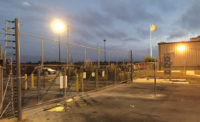Don’t learn the hard way what not to do on an outdoor perimeter installation. We asked integrators to share some of the mistakes they’ve made or seen others make that reduced profitability and to discuss how those mistakes could have been avoided. (Not to put anyone on the spot, we didn’t ask integrators to specify whether it was their own company or another that goofed.)
1. Google Earth does not replace a site survey
Some people love using Google Earth to obtain an aerial view of their site — and nowadays some customers may advise you to use Google Earth to bid a job to install an electric fence or add security sensing to an existing fence. But there’s only so much you can learn from Google Earth, notes Tom O’Brien, owner of St. Augustine, Fla.-based Solid Security.
“There can be hills or grade changes,” explains O’Brien. “Google Earth gives you the layout but it doesn’t give you the ups and downs.” And accommodating those ups and downs can add thousands of dollars to the cost of a job.
“The best thing is to walk the fence yourself,” O’Brien advises. “Then you know what your obstacles are.”
2. Another terrain-related “gotcha”
Knowing the terrain a customer wants to protect is critical for another reason, too. Any equipment installed at high elevation in lightning-prone areas could be subject to lightning strikes — eating into profitability by requiring replacement equipment and a service call.
“If I go to an oil field, I’m going to ask about the weather,” observes Kevin Berry, director of engineering for Houston-based Dowley Security Systems.
Adding lightning arrestor systems, properly grounding the installation and ensuring proper power conditioning are critical to protecting a site against lightning — and although it adds to a job’s costs, it can save money in the long run.
3. Don’t rely on printed lux ratings
If a video camera doesn’t get enough light, image quality suffers — and that can be especially troublesome when a system is using video analytics because the analytics may not work properly, potentially missing an intruder or causing false alarms.
But according to Jacob Loghry, proposal engineering manager for Omaha, Neb.-based G4S Technology, “Lux ratings aren’t entirely accurate.”
If an integrator misjudges the camera’s ability, the company could end up replacing the cameras or adding lighting, entailing substantial unexpected costs.
Loghry says the only way to gauge picture quality is to experiment with a camera model to determine how much lighting it takes to get a satisfactory picture.
4. Don’t overlook average component life
Outdoor perimeter installations often are in remote locations, which means going back to service them can add substantially to ongoing maintenance costs. Mississauga, Ontario-based UCIT Online Security has done installations to protect solar panels that have an average life of about 20 years. For installations such as those, the company likes to use thermal imaging cameras rather than infrared-illuminated cameras because components do not need to be replaced as frequently.
Cameras with infrared illumination may cost less up-front. “But infrared illumination only goes so far and it burns out every three to four years,” observes UCIT President Erik Mikkelsen.
Anyone overlooking that consideration could be in for some substantial unexpected maintenance costs.
5. Give central station personnel the tools they need
Outdoor perimeter installations that use video cameras are sometimes viewed by central station personnel, whose job it is to verify whether alarms are true emergencies or simply nuisance alarms caused by environmental conditions.
“You’re an interactive set of eyes, switching from camera to camera,” comments Bob Ricucci Jr., CEO of Advanced Security Technologies of Riverside, Calif. “The operator needs to know the site and how to manipulate cameras and what to look for.”
To do a good job, operators need site-specific information. But, Ricucci explains, “central station software . . . has for many years been deficient” when it comes to providing site-specific information. The situation is improving, he says: some software supports mapping capability, enabling cameras to be depicted on the map.
But if that isn’t available, operators need booklets depicting the same information, along with the customer’s hours of operation, Ricucci advises. “Sometimes paper still works,” he says — and proper training is essential.
If central station operators don’t have the right tools they might miss someone, for example, improperly loading up a truck and driving away. Explaining why something like that occurred, “can be among the most embarrassing phone calls you have to make,” comments Ricucci.
Conversely, he says, “Nothing is better than to call a customer and say, ‘We saved you $20,000 and police made an arrest.’”
6. Remember to leave slack in fence systems
Outdoor installations can be subject to huge temperature swings and that can cause fence system cabling to expand and contract. That’s why such systems typically require installers to leave some slack when installing the cabling.
“Not having the right expansion loops can be a problem,” observes Darin Dillon, business development manager for Schaumburg, Ill.-based Convergint Technologies.
Doing that right adds little or nothing to the cost of a job and can help ensure the long-term profitability of the installation.
7. Municipalities don’t always own their infrastructure
When an integrator does a job for a municipality, the customer may assume that there’s no problem installing equipment on light poles or other public infrastructure. But that’s not always true, cautions Eric Yunag, president and CEO of Sioux Falls, S.D.-based Dakota Security Systems.
“Part of the design and engineering process is to determine proper right of way,” comments Yunag. He advises integrators to work carefully with their clients to determine if any infrastructure planned to be used is truly the client’s asset.
Failure to do so may entail a simple slap on the wrist or could have more serious consequences such as requiring the equipment to be re-positioned, sometimes requiring the installing company to install its own pole.
MORE ONLINE
For more practical advice on outdoor perimeter protection, check out SDM’s previous coverage on this topic.
Several articles have profiled successful outdoor perimeter installations:
• www.sdmmag.com/articles/outdoor-idea-bank
• www.sdmmag.com/articles/creative-solutions-to-outdoor-security-problems
Test your outdoor perimeter protection knowledge by taking these quizzes:
• www.sdmmag.com/articles/perimeter-motion-detectors-on-the-move
• www.sdmmag.com/articles/87890-outdoor-and-perimeter-protection
Learn about products for outdoor perimeter protection here:










